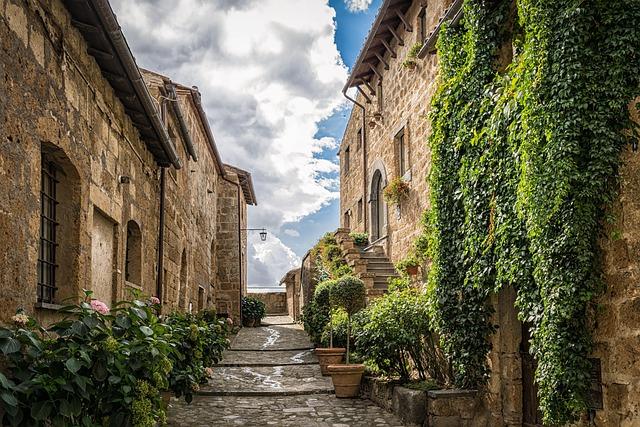Lately, Italy’s engagement with Libya has advanced into a fancy internet of political, financial, and humanitarian pursuits, reflecting the wider geopolitical dynamics of the Mediterranean area. As Libya grapples with ongoing conflicts and a fractured political panorama,italy unearths itself at the leading edge of diplomatic efforts,pushed by means of a combine of previous ties,strategic issues,and the urgent want to regulate migration flows from North Africa. This text delves into the more than a few components shaping Italy’s coverage in Libya, inspecting the interaction between nationwide safety, power pursuits, and Ecu Union dynamics. Through examining contemporary traits and key gamers, we goal to supply a complete figuring out of what motivates Italy’s movements in a nation that continues to be pivotal to each its home and international coverage agendas.
Figuring out Italy’s Historic Ties to Libya and Their Affect on Present Coverage
Italy’s courting with Libya is deeply rooted in a advanced historical past that spans over a century, impacting fresh diplomatic and financial insurance policies. Following the Italian colonization of Libya from 1911 to 1943, the legacies of this period have persevered, shaping perceptions and interactions between the two international locations.The cultural ties, which come with shared language and customs, serve as a basis for social engagement, whilst ancient grievances linger, influencing public sentiment and political rhetoric. In present discussions surrounding immigration and safety, those ancient ties are ofen invoked, showcasing how previous relationships can dictate provide coverage dynamics.
Additionally, Italy’s strategic pursuits in Libya are pushed by means of financial issues, particularly within the power sector. As a significant importer of libyan oil and herbal gasoline, Italy targets to protected its power provide amidst emerging geopolitical tensions and festival from different eu international locations. This financial dependency is complemented by means of a push to determine Libya as a solid spouse within the mediterranean. The next table highlights key elements of Italy’s present coverage way:
| Coverage Focal point | Targets | Demanding situations |
|---|---|---|
| Power Partnerships | Ensure that solid oil and gasoline provides | Political instability in libya |
| Immigration Keep an eye on | Arrange migrant flows to Italy | Humanitarian issues and world grievance |
| Diplomatic Engagement | Improve a unified Libyan govt | Fragmented political panorama |

Financial Pursuits at stake: Inspecting Italy’s Power and Industry Dependencies in Libya
Italy’s engagement with libya is deeply intertwined with its financial imperatives, in particular within the nation-states of power and industry. The libyan panorama provides now not onyl an unlimited reservoir of oil and gasoline assets however additionally a strategic gateway for Italian firms having a look to capitalize on North African markets. As Europe grapples with an power disaster exacerbated by means of geopolitical tensions, Italy’s dependency on Libyan crude oil has emerged as a key consider shaping its international coverage. Components using this dependency come with:
- Oil imports: Libya is amongst the highest providers of oil to Italy, handing over a significant proportion of its crude imports.
- Fuel Provide: The Italian power corporate ENI has primary investments in Libya, making it vital for Italy’s gasoline provide traces.
- Infrastructure Investments: Italian companies are actively excited by Libyan infrastructure initiatives, making a symbiotic financial courting.
Additionally, Italy’s industry pursuits prolong past power, encompassing more than a few sectors such as development, telecommunications, and agriculture. The rebuilding and stabilization of Libya post-conflict create a large number of alternatives for Italian companies.Moreover, Italy’s geographical proximity facilitates ease of get admission to, bettering industry potency.Key issues come with:
- Industry Agreements: Italy seeks to determine powerful industry frameworks that receive advantages each international locations economically.
- Migration Coverage: Italy’s insurance policies against migration can affect its financial dealings in Libya, in particular referring to hard work and industry.
- Cultural ties: Historic connections between the 2 international locations bolster Italy’s affect and operational footprint in libya.

Safety Considerations: The Position of Migration and Human Trafficking in Shaping Italy’s Means
As Italy grapples with a advanced internet of migration and human trafficking, its nationwide safety technique has an increasing number of pivoted against a extra proactive stance, in particular in its dealings with Libya. The Mediterranean Sea serves as a significant transit path for migrants searching for safe haven in Europe, making Italy the frontline state within the migration disaster. In consequence, the Italian govt has been pressured to give a boost to its border regulate measures and have interaction in strict agreements with the Libyan government to discourage boats from departing. Those efforts goal to deal with nationwide safety issues by means of lowering unlawful crossings, that are regularly sufficient connected to arranged crime and human trafficking networks. Larger investment and beef up for Libya’s Coast Guard will also be observed as an instantaneous reaction to the emerging selection of migrants,in addition to an try to curb the affect of traffickers who exploit susceptible populations.
Additionally, this partnership raises moral and humanitarian questions surrounding Italy’s method to migration. Critics argue that by means of prioritizing safety over the welfare of migrants, Italy would possibly unwittingly give a contribution to the perpetuation of human rights abuses inside of libya’s detention facilities. Those facilities have been broadly condemned for his or her harsh prerequisites and the remedy of detainees, who ceaselessly face violence and exploitation. In consequence, the steadiness between making sure nationwide safety and addressing humanitarian duties stays a contentious factor. Italy’s coverage choices, formed by means of each home and world pressures, illustrate the intricate courting between migration dynamics, safety imperatives, and human rights issues within the evolving geopolitical panorama.

Geopolitical Dynamics: Italy’s Place Inside of Ecu and World Efforts in Libya
Italy’s geopolitical engagement in Libya is formed by means of a confluence of ancient ties, financial pursuits, and Ecu Union dynamics.Situated as a key participant within the Mediterranean, Italy leverages its proximity to Libya to exert affect over ongoing traits. The nation’s colonial previous and longstanding relationships supply Italy with each a diplomatic platform and an ethical legal responsibility to stabilize the area. This aligns with broader Ecu efforts to mitigate the fallout of instability, together with problems similar to migration and safety. Amidst a backdrop of fluctuating alliances, Italy has taken a proactive stance in addressing the humanitarian crises stemming from Libya, reinforcing its dedication to Ecu norms of governance and human rights.
Along with humanitarian efforts, Italy’s financial imperatives additionally power its coverage method. The country seeks to protected strategic power partnerships and give a boost to industry alternatives, positioning itself as a gateway for Ecu funding in Libya. Significantly, Italian firms have important stakes within the Libyan oil and gasoline sector, emphasizing the significance of a stable political landscape to safeguard investments. Moreover, the collaboration with world entities such because the United Countries and the African union showcases Italy’s position in facilitating conversation and peace-building tasks. this multi-faceted way allows Italy to navigate the advanced internet of native dynamics whilst announcing its affect throughout the broader framework of Ecu and world methods.
| Key Components influencing Italy’s Coverage in Libya | Have an effect on on Italy |
|---|---|
| Historic Ties | Enhanced diplomatic leverage |
| Financial Pursuits | Secured power partnerships |
| Migration Considerations | Stabilization as a concern |
| EU collaboration | More potent regional affect |

Suggestions for Long run Engagement: Balancing Humanitarian Wishes with Nationwide Pursuits
To successfully navigate the advanced waters of humanitarian engagement in Libya whilst respecting nationwide pursuits,it can be crucial for Italy to undertake a multifaceted way.Stakeholders will have to prioritize collaboration with native NGOs to make sure that humanitarian efforts are culturally delicate and sustainable. constructing partnerships with organizations that experience deep roots within the group can give a boost to provider supply and bolster consider, making it more uncomplicated to deal with the vital wishes of displaced populations. Moreover, Italy will have to imagine the combination of human rights tracking inside of its engagement framework, thereby aligning its international coverage with broader world humanitarian requirements.
Moreover, organising a clear discussion with Libyan government can create mutually recommended avenues for addressing each safety issues and humanitarian efforts. It’s certainly crucial to strike a steadiness between immigration regulate and the security of susceptible communities.This will also be facilitated thru:
- Joint coaching techniques for Libyan coast guard and humanitarian reaction groups.
- Funding in native infrastructure to give a boost to residing prerequisites for migrants and refugees.
- Improve for construction initiatives that cope with the root reasons of migration.
Through prioritizing those components, Italy cannot simplest satisfy its humanitarian commitments but in addition protected its nationwide pursuits in a risky area.
To Conclude
Italy’s multifaceted method to its coverage in Libya is formed by means of a mix of ancient ties,financial pursuits,and geopolitical issues. As Rome seeks to say its affect in North Africa, it navigates a advanced panorama marked by means of migration problems, power safety, and political instability. The Italian govt’s methods divulge a concerted effort to strike a steadiness between humanitarian duty and nationwide hobby,aligning with broader Ecu goals whilst addressing native dynamics. As Libya continues to grapple with its demanding situations, Italy’s position can be the most important in shaping the area’s long run, making it crucial for policymakers to stay agile and conscious of the evolving scenario. Figuring out the intricacies at the back of Italy’s engagement in libya will stay crucial because the world group grapples with the wider implications of instability in this key North African country.
Source link : https://afric.news/2025/03/08/opinion-what-is-driving-italys-policy-in-libya-the-africa-report/
Writer : Atticus Reed
Submit date : 2025-03-08 02:29:00
Copyright for syndicated content material belongs to the connected Source.



